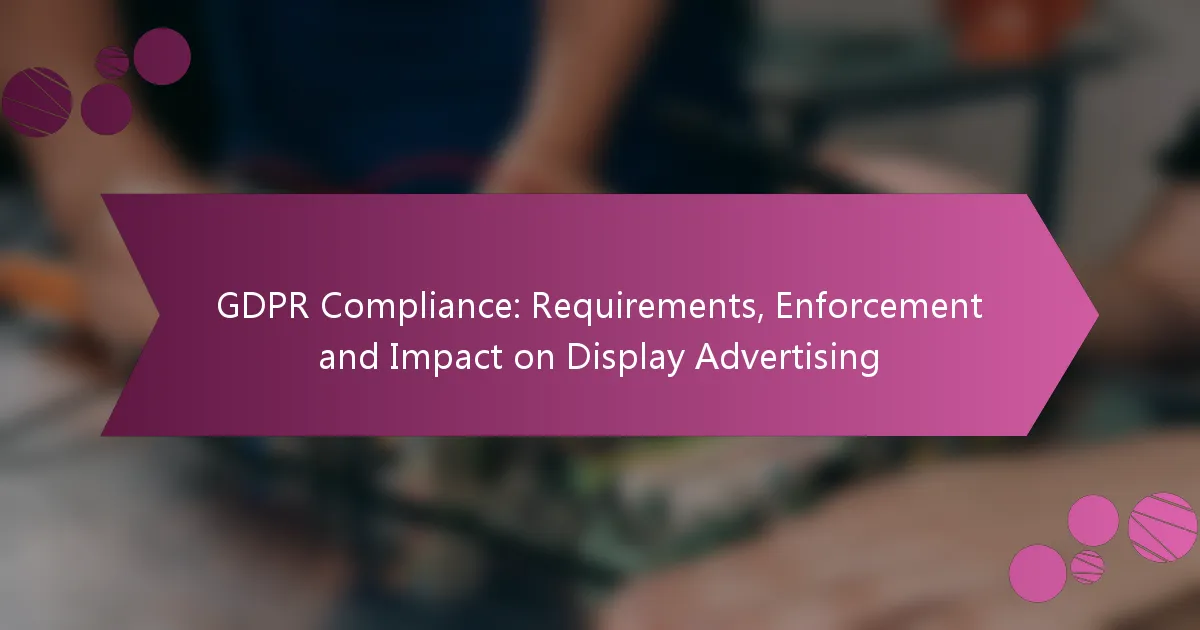The General Data Protection Regulation (GDPR) has a profound impact on display advertising in the US, introducing stringent rules regarding data collection and user consent. Advertisers are required to comply with these regulations while still striving to implement effective advertising strategies, necessitating a careful balance between compliance and performance.
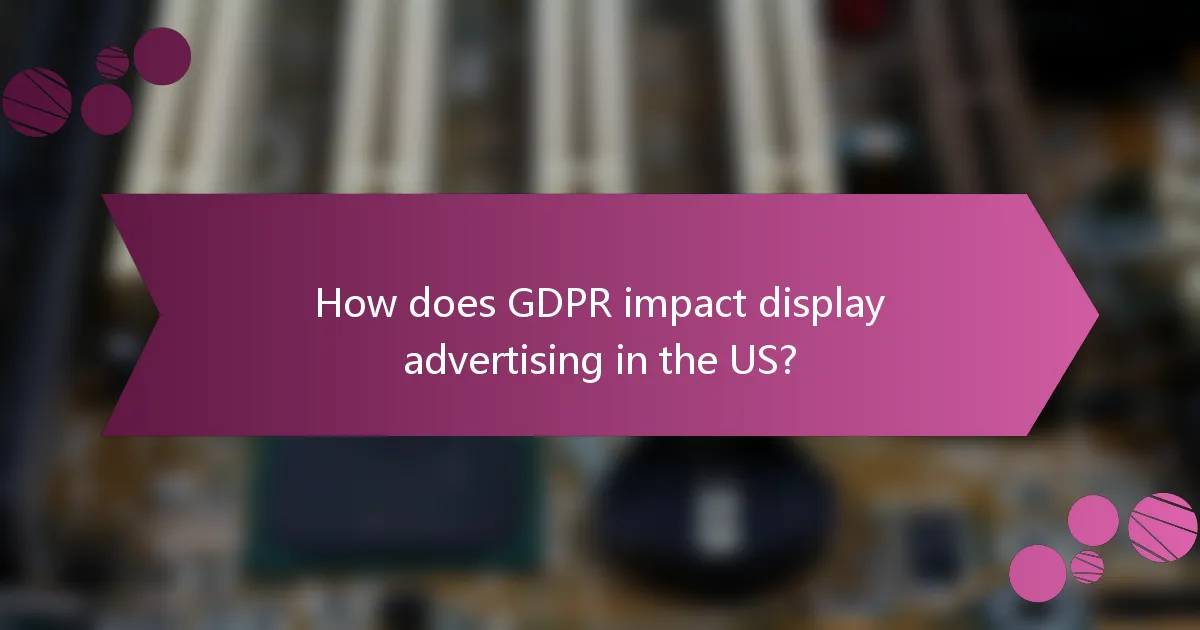
How does GDPR impact display advertising in the US?
The General Data Protection Regulation (GDPR) significantly affects display advertising in the US by imposing strict rules on data collection and user consent. Advertisers must navigate these regulations to ensure compliance while maintaining effective advertising strategies.
Increased user consent requirements
GDPR mandates that advertisers obtain explicit consent from users before collecting or processing their personal data. This means that display ads must include clear opt-in options, and users should be informed about how their data will be used.
To comply, advertisers should implement transparent consent management platforms that allow users to easily manage their preferences. Failing to secure proper consent can lead to hefty fines and damage to brand reputation.
Data processing limitations
Under GDPR, the processing of personal data is restricted to specific purposes, such as delivering targeted ads. Advertisers must ensure that data collection aligns with these purposes and that they have a legal basis for processing.
For example, using anonymized data can help mitigate compliance risks while still enabling effective advertising. Advertisers should regularly review their data processing activities to ensure they remain within legal boundaries.
Impact on ad targeting strategies
The need for user consent and data processing limitations under GDPR can alter traditional ad targeting strategies. Advertisers may need to shift from highly personalized ads to broader audience targeting to comply with regulations.
Additionally, the reliance on first-party data becomes more critical, as it is often easier to obtain consent for data collected directly from users. Advertisers should consider developing loyalty programs or engaging content to build a robust first-party data pool.

What are the key requirements for GDPR compliance?
The key requirements for GDPR compliance focus on protecting personal data and ensuring individuals have control over their information. Organizations must implement specific measures to safeguard data, respect user rights, and maintain transparency in data processing activities.
Data subject rights
Data subject rights under GDPR empower individuals to have greater control over their personal information. Key rights include the right to access their data, the right to rectify inaccuracies, the right to erase data, and the right to object to processing.
Organizations must establish processes to facilitate these rights, such as providing easy access to data and clear mechanisms for users to request changes or deletions. Failure to comply can result in significant fines and reputational damage.
Data protection by design
Data protection by design requires organizations to integrate data protection measures into their processing activities from the outset. This means considering privacy implications during the development of products and services, rather than as an afterthought.
Practically, this can involve conducting data protection impact assessments (DPIAs) to identify risks and implement necessary safeguards. For instance, using encryption and anonymization techniques can help protect sensitive data effectively.
Record-keeping obligations
GDPR mandates that organizations maintain detailed records of their data processing activities. This includes documenting the types of data processed, the purposes of processing, and any third parties involved.
Keeping accurate records not only aids compliance but also demonstrates accountability. Organizations should regularly review and update these records to reflect any changes in processing activities or data handling practices.
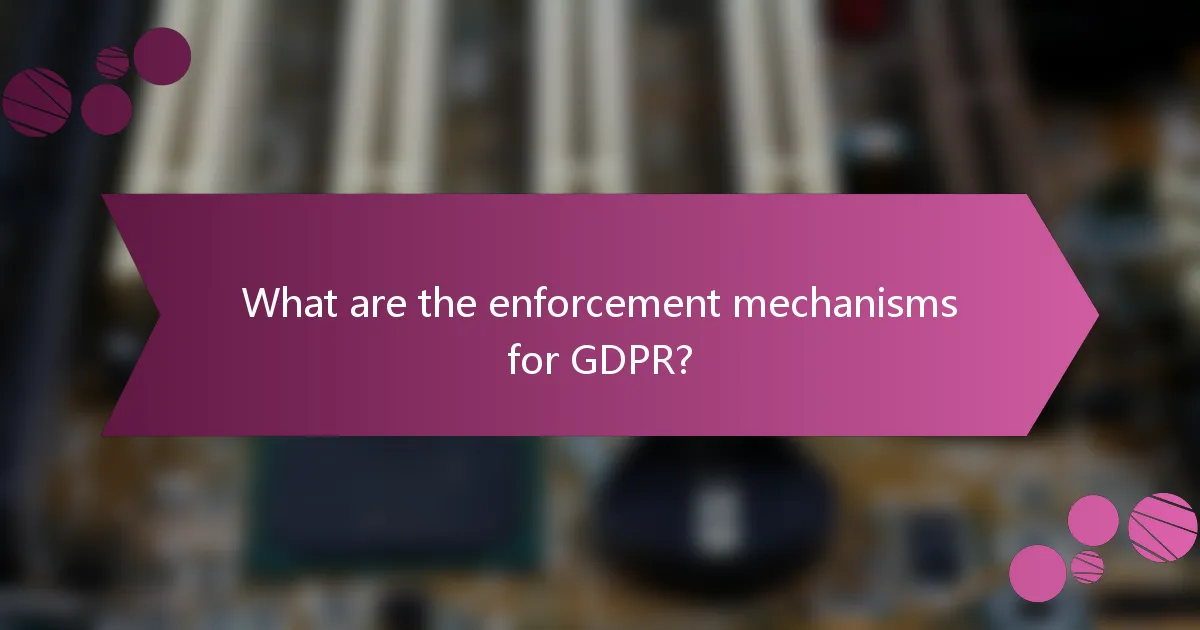
What are the enforcement mechanisms for GDPR?
The enforcement mechanisms for GDPR include various measures that ensure compliance with the regulation, primarily through fines, penalties, and oversight by regulatory authorities. These mechanisms are designed to hold organizations accountable for data protection violations and to protect individuals’ privacy rights.
Fines and penalties
GDPR imposes significant fines for non-compliance, which can reach up to 4% of a company’s global annual revenue or €20 million, whichever is higher. This tiered approach means that the severity of the violation determines the fine, with more serious breaches attracting larger penalties.
Organizations should be aware that fines are not the only consequence; they may also face reputational damage and loss of customer trust. To mitigate risks, companies should conduct regular audits and ensure they have robust data protection measures in place.
Regulatory authority involvement
Regulatory authorities play a crucial role in enforcing GDPR by investigating complaints, conducting audits, and imposing sanctions. Each EU member state has its own supervisory authority responsible for overseeing compliance within its jurisdiction.
In cases of serious violations, authorities may initiate investigations based on complaints from individuals or other organizations. Companies should establish clear communication channels with these authorities and be prepared to cooperate fully during any inquiries or audits.
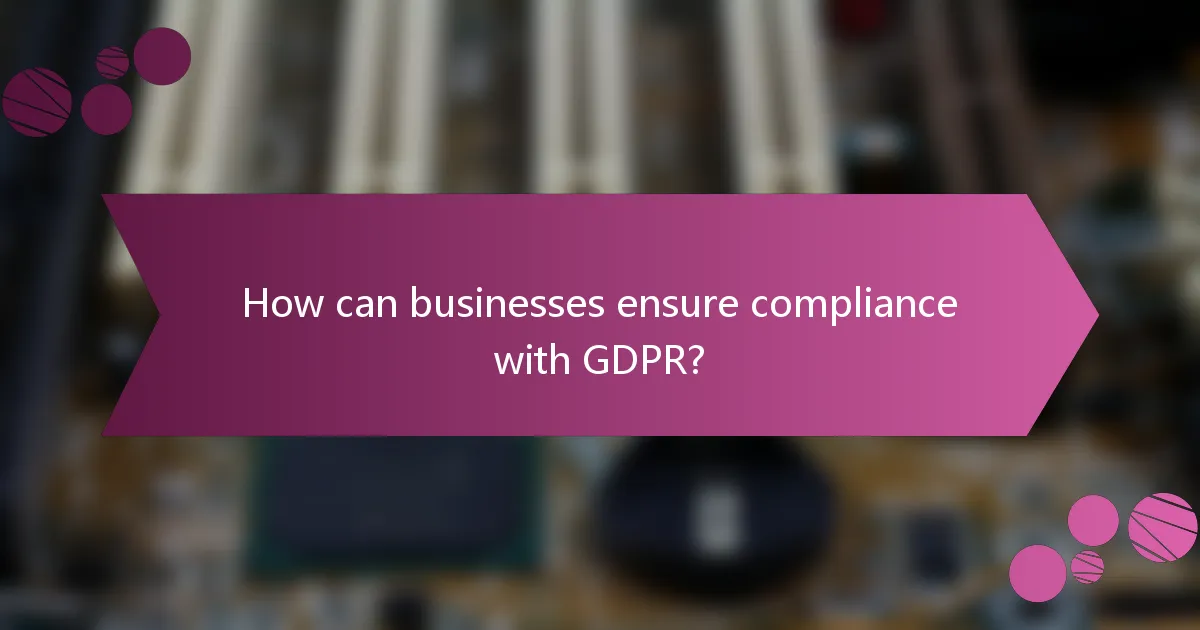
How can businesses ensure compliance with GDPR?
Businesses can ensure compliance with GDPR by implementing robust data protection measures, obtaining explicit consent from users, and regularly reviewing their practices. Key steps include utilizing consent management platforms, conducting compliance audits, and training staff on data privacy regulations.
Implementing consent management platforms
Consent management platforms (CMPs) are essential tools for businesses to manage user consent effectively. These platforms help organizations collect, store, and manage consent preferences in a transparent manner, ensuring compliance with GDPR requirements. By using a CMP, businesses can provide users with clear options regarding data collection and processing.
When selecting a CMP, consider factors such as ease of integration with existing systems, user interface design, and compliance features. Popular options include OneTrust, TrustArc, and Cookiebot, which offer various functionalities to suit different business needs.
Regular compliance audits
Conducting regular compliance audits is crucial for maintaining GDPR adherence. These audits help identify potential gaps in data protection practices and ensure that the organization is following established protocols. Businesses should schedule audits at least annually or whenever significant changes occur in data processing activities.
During an audit, assess areas such as data collection methods, consent records, and data retention policies. A checklist can help streamline the process, focusing on key compliance areas like user rights, data security measures, and third-party data sharing practices.
Staff training and awareness programs
Staff training and awareness programs are vital for fostering a culture of data protection within an organization. Employees should understand GDPR principles, their responsibilities regarding data handling, and the importance of user consent. Regular training sessions can help keep staff informed about updates to regulations and best practices.
Consider implementing interactive training modules, workshops, or e-learning courses that cover practical scenarios employees may encounter. Encouraging open discussions about data privacy can further enhance awareness and compliance across all levels of the organization.
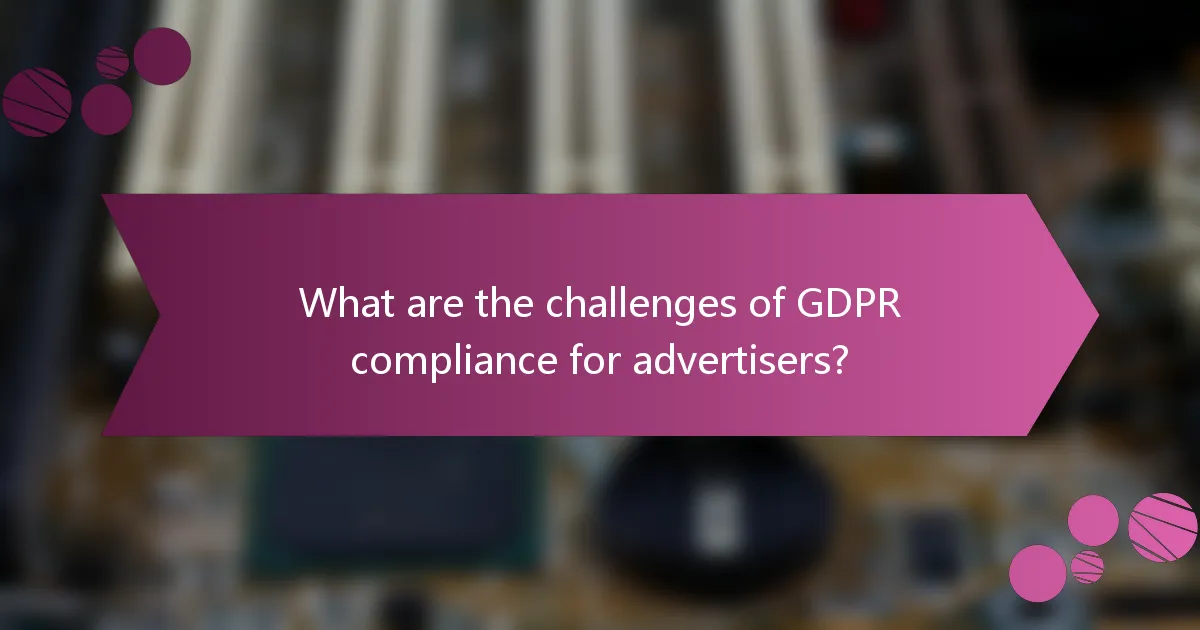
What are the challenges of GDPR compliance for advertisers?
Advertisers face significant challenges in achieving GDPR compliance, primarily due to the stringent requirements for data protection and user consent. These challenges can complicate advertising strategies and limit the effectiveness of data-driven campaigns.
Complexity of consent management
Managing user consent under GDPR is complex, as it requires clear communication and documentation of how personal data will be used. Advertisers must implement systems that allow users to easily give, withdraw, or modify their consent, which can involve significant technical and administrative resources.
For example, consent must be obtained before any data collection, and advertisers must provide transparent information about data usage. Failure to manage consent properly can lead to hefty fines, making it crucial for advertisers to establish robust consent management processes.
Impact on data-driven marketing
The GDPR has a profound impact on data-driven marketing by restricting how advertisers can collect and utilize personal data. Many advertisers now face limitations on targeting and personalization, which can reduce the effectiveness of campaigns and lead to lower conversion rates.
Advertisers may need to rely more on aggregated data or contextual advertising strategies instead of personalized approaches. This shift can require a reevaluation of marketing tactics and a focus on building trust with consumers to encourage voluntary data sharing.
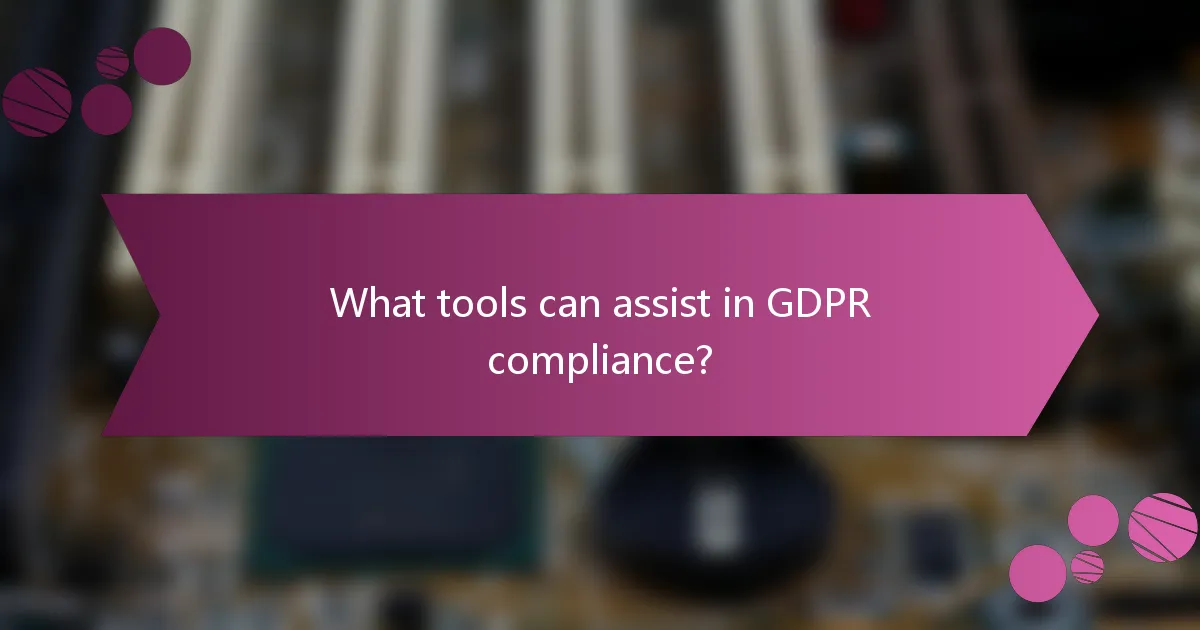
What tools can assist in GDPR compliance?
Several tools can help organizations achieve GDPR compliance, particularly in managing user consent and data protection. These tools streamline processes, ensuring that businesses adhere to regulations while maintaining user trust.
OneTrust for consent management
OneTrust is a leading platform for managing user consent in accordance with GDPR requirements. It provides businesses with the ability to create customizable consent banners that inform users about data collection practices and allow them to opt-in or opt-out easily.
Using OneTrust, organizations can track user consent preferences and maintain detailed records, which are essential for demonstrating compliance during audits. The platform also offers features like automated updates to privacy policies and cookie compliance management.
To effectively implement OneTrust, businesses should regularly review their consent management strategies and ensure that the consent banners are clear and user-friendly. Avoid common pitfalls such as using ambiguous language or failing to provide users with easy access to their consent preferences.





